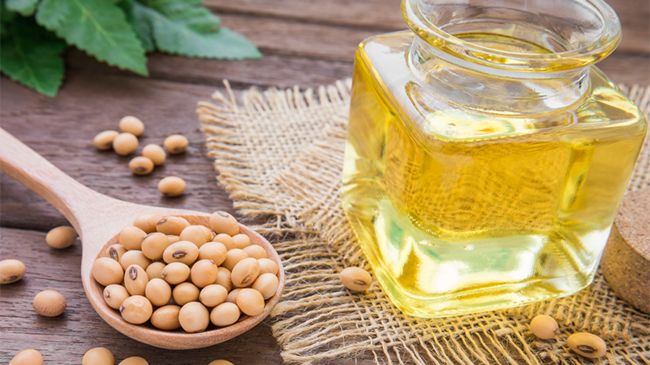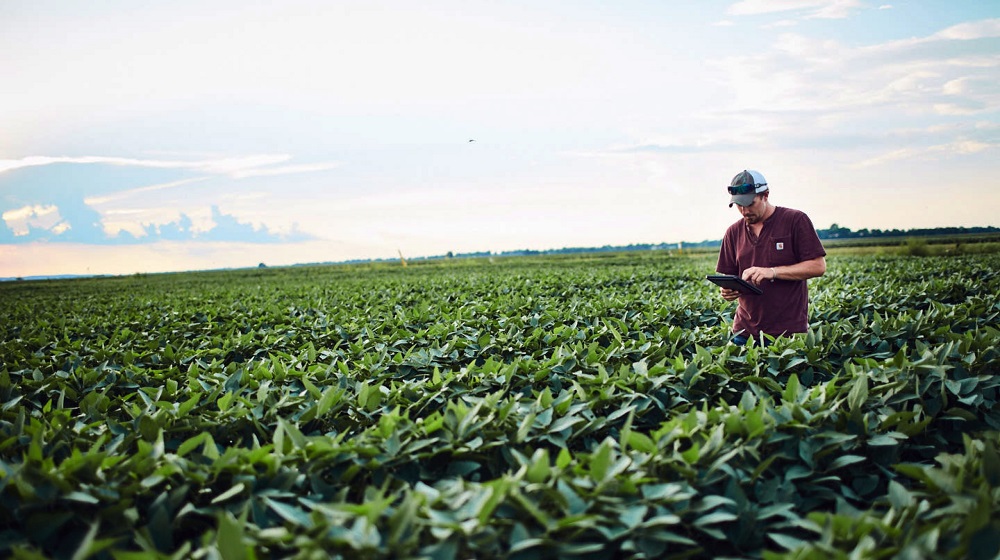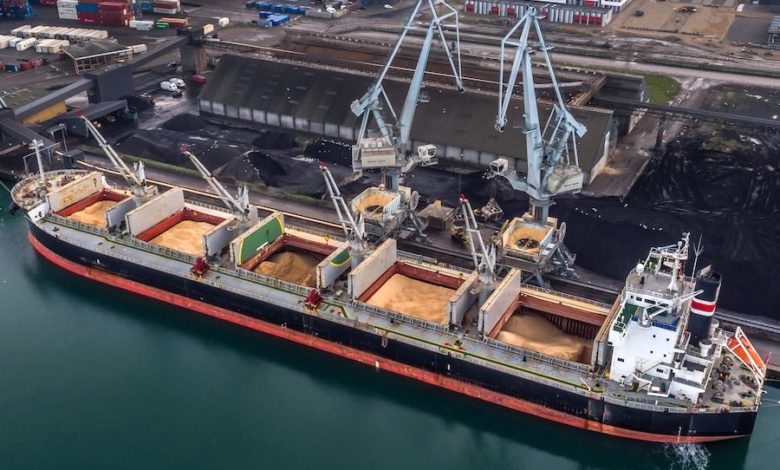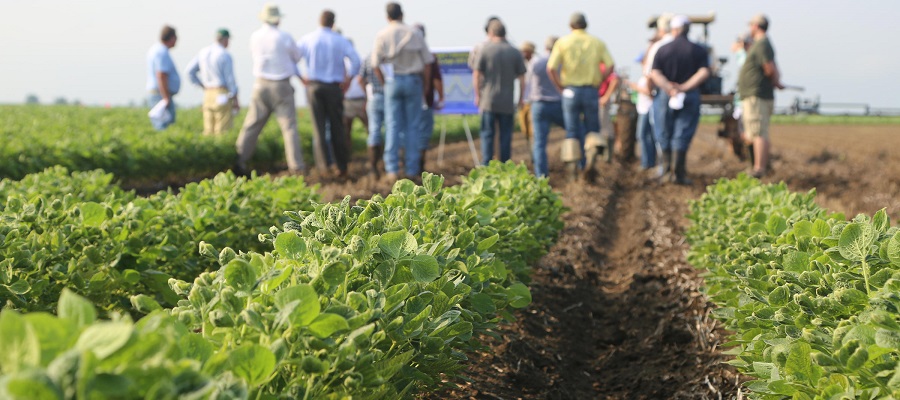The mass farming of soybeans is a major topic. Soybeans are grown on land that was once tropical rainforest. The bean is used worldwide in factory farms as a cheap, protein-rich feed. A few large corporations produce, process and trade the soybeans according to industrial standards.
Before we get to the mass farming of soybeans, let's talk about the commodity. The soybean (Glycine max) is an annual shrubby plant that botanically belongs to the butterfly family (legumes). The beans develop in about 100 days. Originally, the soybean comes from China and already at the beginning of the 20th century it found its way to North and South America. But it was not until the 1990s that the miracle bean began its triumphal march. Today, the largest producers of soybeans are Brazil and the USA, followed by Argentina and China.
The soybean contains about 36% protein, with it the protein supply of humans could be ensured. At 36 grams, 100 grams of soybeans, about a small jar, contain just as much protein as a 150-gram beef steak (38 grams).
Only six percent of the world's soybean harvest, mainly in Asia, is used directly for human consumption in the form of soybean sprouts, soybean oil, tofu, etc. The vast majority of soybeans is used as food. By far the larger part is fed as high-protein feed to cattle, pigs and poultry in factory farms. Soy is increasingly used in aquaculture for farmed salmon, and it is also included in pet food.
Soybean oil and soybean meal
Because whole soybeans are indigestible to fattening animals, they must be processed beforehand. In Hamburg, there are oil mills that process the soybeans exported by ship. In complicated processes, the oil (about 20 percent or more) is extracted from the beans by means of extraction and/or pressing. What remains is soybean meal, which has a high protein content but only a low fat content.

Soybean oil
The brownish-yellow soybean oil can be used as a vegetable oil in the food sector, or it is processed into agricultural fuels ("biodiesel"). The protein-containing soybean meal is used as feed in factory farming.
Soy in factory farming (Mass farming of soybeans)
As of May 2019, there are about 11.8 million cattle, 25.9 million pigs, 1.6 million sheep and 41.4 million laying hens in Germany alone (Bundesamt für Statistik, 2019). Together, they are heavier than all 82 million inhabitants of Germany. In Austria, as of December 2018, there are about 1.9 million cattle and 2.8 million pigs. And somehow, these farm animals have to be fed. Our domestic acreage for growing feed is too small for that.
So where does the feed come from? The feed has to be imported, and mainly in the form of soy. That is why soy has become indispensable as feed in the factory farms of Europe, North America and China. It is mainly fed to pigs, poultry and also cattle.
Soy in factory farming

Mississippi Soy Farming - Source: mssoy.org
As of May 2019, there are about 11.8 million cattle, 25.9 million pigs, 1.6 million sheep and 41.4 million laying hens in Germany alone (Bundesamt für Statistik, 2019). Together, they are heavier than all 82 million inhabitants of Germany. In Austria, as of December 2018, there are about 1.9 million cattle and 2.8 million pigs. And somehow, these farm animals have to be fed. Our domestic acreage for growing feed is too small for that.
So where does the feed come from? The feed has to be imported, and mainly in the form of soy. That is why soy has become indispensable as feed in the factory farms of Europe, North America and China. It is mainly fed to pigs, poultry and also cattle.
Our livestock are literally eating the rainforest. Former German Environment Minister Sigmar Gabriel put it in a nutshell in May 2008: "The profiteers of rainforest deforestation are far more the German farmers than the Brazilian farmers". This quote could well be supplemented by the Chinese farmers, because China's hunger for meat is enormous. Today, China already consumes twice as much meat as the U.S. - and consumption is rising. In satisfying its hunger for meat, China receives significant support from Germany. In 2019, Germany exported 639,000 tons of meat (excluding poultry) worth 1.26 billion euros to China.
Origin of soybeans
Undemanding soybeans are grown on vast tracts of land in South America that were once covered by unique tropical rainforests and savannas (cerrados). In 2019, Brazil was the largest producer of soybeans, ahead of the United States, with 114 million tons. The triumph of the Brazilian bean began with the U.S. ban on soybean exports imposed in 1973, which caused demand for the cheap Brazilian soybeans to skyrocket.
In addition, Brazilian soybeans are easier to sell because the percentage of genetically modified soybeans is still relatively low compared to U.S. soybeans. Interestingly, with the exception of one Brazilian company, Brazilian soybean production is firmly in the hands of foreign companies.
Because global demand for soybeans is increasing, Brazil's production of soybeans nearly tripled from 43 million tons to 114 million tons in the 15 years between 2002 and 2019. During the same period, 180,000 square kilometers (km2) of rainforest were cleared in the Brazilian Amazon. Most of this in the soy states of Mato Grosso, Para and Rondonia, 148,000 km2. In total, 359,000 km2 of soybeans were grown in Brazil in 2019. This is roughly equivalent to Germany's area of 357,000 km2.
Soybean Exports
Mass farming of soybeans leads to mass export. In 2017, Brazil exported 81.8 million tons of soy products, of which 66.7 million tons were soybeans, 13.7 million tons were soybean meal, 1.2 million tons were soybean oil and others. The main buyers of soybeans were China with 52.6 million tons, followed by the Netherlands with 3.8, Thailand with 3.5 and Spain with 2.3 million tons. Only 1.4 million tons were exported to Germany (resourcetrade.earth, 2019).

Shipping soybeans
Unlike Brazil, Argentina exports less soybeans than soybean meal. In 2017, Argentina exported 41.1 million tons of soy products, of which 28.3 million tons were soybean meal, 7.7 million tons were soybeans, 5 million tons were soybean oil, and others (resourcetrade.earth, 2019). The soybean meal was mainly imported from Vietnam, Indonesia, Italy, Spain and Poland.
The billion-dollar soybean business
The mass farming of soybeans created a billion dollar industry. The production and processing of the gigantic quantities of soy is carried out efficiently and homogeneously almost everywhere in the world according to the standards of industrial agriculture (agro-industry), for example by always using the same seeds, the same weed killers and the same trade routes. Behind this are essentially five agribusinesses that have divided up the world soybean market among themselves:
- Bunge Limited is a global food company headquartered in the U.S. that exports soybeans, processes oilseeds, and also produces agrofuels ("biodiesel"), among other products;
- Monsanto, the U.S. subsidiary of Bayer AG, Germany, is the world's largest seed producer, is a leader in the production of genetically modified crops, and also produces the weedkiller "RoundUp" (glyphosate);
- Archer Daniels Midland (ADM), headquartered in the USA, is one of the largest processors of soy products and operates oil mills for this purpose worldwide, including in Germany, for example in Hamburg;
- Cargill Incorporated is a U.S.-headquartered agricultural group that trades in everything related to food and its production; Cargill products end up in practically every supermarket shopping cart;
- Louis Dreyfus Company (LDC) is an agricultural group headquartered in the Netherlands and one of Cargilll's largest competitors.
Together with the world's largest processor of palm oil, Wilmar International, headquartered in Singapore, these five agribusinesses control up to 90 percent of the global grain trade (Mighty Earth, 2018). Because of their size, agribusinesses have enormous power in international trade. They also play a direct role in ecosystem destruction, for example, by providing financing, fertilizer, infrastructure, and other incentives for deforestation to plantation owners and farmers. This creates dependencies that secure the corporations' supply base.
The Brazilian soy moratorium
The mass farming of soybeans had an impact on Brazil too. In July 2006, non-governmental organizations (NGOs) and soy wholesalers in Brazil signed the first voluntary agreement to stop trade in soy grown on illegally cleared rainforest land. The soy moratorium was born. It was the first moratorium of its kind in the tropics and was intended to serve as a model for other agricultural products from Brazil, such as beef and palm oil. The soy moratorium was extended in November 2014 and ran until May 2016, during which time it was monitored by the Brazilian government using surveillance flights and satellite imagery analysis.
The soy moratorium was a success, as since then hardly any additional rainforest has been cleared in Brazil to increase the area under soy cultivation. After the end of the soy moratorium in May 2016, the Brazilian government itself was supposed to protect the Amazon rainforests by means of effective environmental laws ("Código Florestal"). However, environmental organizations and scientists are skeptical and are calling for the soy moratorium to be extended beyond this date. This is because waning public interest and rising demand for soy are already putting renewed pressure on the tropical rainforests of the Amazon. And as can be seen from the rising deforestation rates in 2019 under President Bolsonaro's government, they were right.
Social consequences
The mass farming of soybeans has its social consequences. Brazil is one of the leading countries in feed exports, and people still suffer from deficiencies due to poor nutrition. While many Brazilians have too little to eat, the country exports millions of tons of soy. This is often the case in tropical countries. The rainforests are not cleared to feed their own population, but to create vast pastures for cattle, and plantations for soy and palm oil. The amount of land that is cleared to feed its own population is not taken into account in this calculation.
The trade in soy in the Brazilian agricultural sector is geared toward large producers; small farmers have been forced out of the markets and cannot sell their soy profitably. Individual soy farms cover an area of up to 2,400 km2, which is more than three times the area of Hamburg. These soy farms mainly use machinery, for which only a few workers are needed. A soy farmer therefore employs on average only 1.7 workers on one hectare of a soy farm, while 30 people find work on one hectare of a family farm. In addition to growing unemployment due to land conflicts and evictions in already poor regions, this also exacerbates the food supply situation.
Ecological consequences of the soy boom
Although the Brazilian government talks about environmental protection, it also wants to earn foreign currency at any cost because the country is heavily in debt. For this reason, new roads are being driven into the jungle or expanded. The BR 163, the Brazilian Soy Highway, for example, stretches more than 1,700 kilometers across the Brazilian rainforest. Soybeans are transported along this road from the state of Mato Grosso, a main soybean growing region, to Santarem on the Amazon. From there, ships transport the soy on the Amazon to the large loading stations on the Atlantic and from there on to the rest of the world, mainly to China and Europe. The cultivation of soy leads to serious environmental problems:
- Brazil is now one of the largest buyers/consumers of weed killers in the world.
- Carbon dioxide sequestered in the vegetation of intact tropical rainforests is released into the atmosphere in large quantities, exacerbating climate change.
- Large amounts of energy must be provided for the production of soy and its subsequent transport to the livestock farms of industrialized nations.


